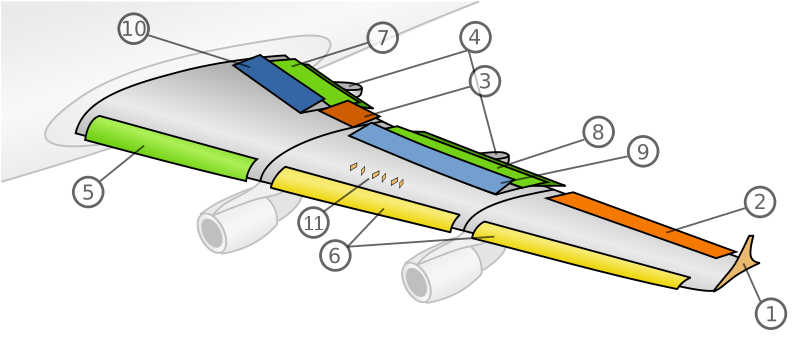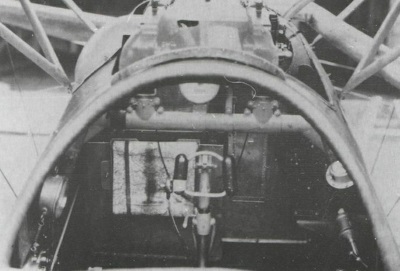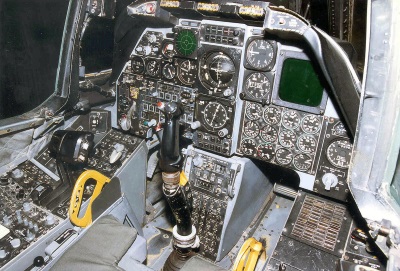Aircraft Components
| Site: | Open Flight School |
| Course: | Theory Basic Course |
| Book: | Aircraft Components |
| Printed by: | Guest user |
| Date: | Sunday, 14 December 2025, 3:25 AM |
1. Fuselage
The fuselage of the aircraft connects all components and provides the necessary transport capacity. In the fuselage of the aircraft sit the pilot(s), the passengers, and the load to be carried is primarily accommodated here.
The shape of the fuselage contributes significantly to aerodynamics, and slim, lightweight construction is the rule. Since in the other assemblies of an airplane there is usually no space for the many devices, computers, hydraulic system, etc. as well as often the fuel tanks are integrated in the fuselage.
2. Wings
The wings of an airplane are the primary supporting structure. They carry the aircraft by creating lift through their design. Wings can have many different shapes and lengths, there are short thick, long narrow, delta wings in triangular form and self-rotating wings. A helicopter flies only because of the rotating wings. Aerodynamically this is no different from conventional aircraft wings.
The design of the wing significantly determines the flight characteristics of an aircraft. Short and thick wings often have much more lift than a long, narrow and thin wing. However, the resistance increases with increasing speed.
3. Engines
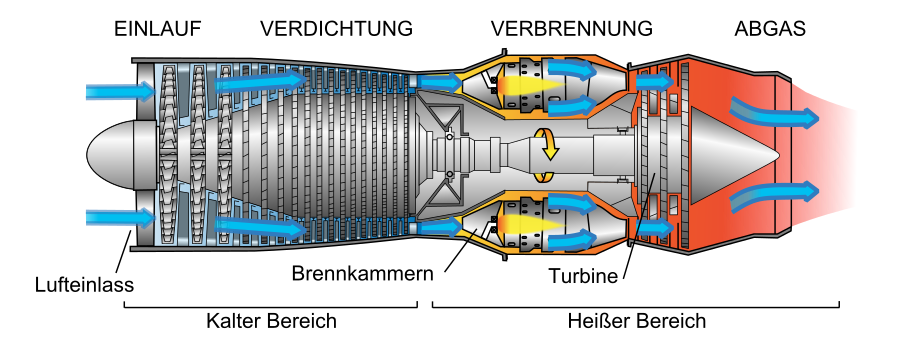 An engine is the power plant of an airplane. This provides the necessary propulsion, i.e. the thrust. An airplane which does not move forward. Usually does not fly.
An engine is the power plant of an airplane. This provides the necessary propulsion, i.e. the thrust. An airplane which does not move forward. Usually does not fly.
Small, light and slow flying aircraft need only small engines. A better lawnmower engine often still serves the purpose today. Typical private airplanes of today or fighter planes from the First World War fly with engines that could well come from a car in terms of performance, and this is often the case. Common for these are from 1,000 ccm with 100 HP up to the thick V8 with 4 liters capacity and 350 HP and more per engine.
Similar to cars, size and weight of an airplane and of course the expected wind resistance at the desired speed determine the necessary propulsion.
Typical engines of today are:
- Piston Engine with propeller (as In-Line or Radial engine, in the past also Rotary engines)
- Jet Engine
- Turboprop (a small jet engine combined with a propeller)
4. Control Surfaces
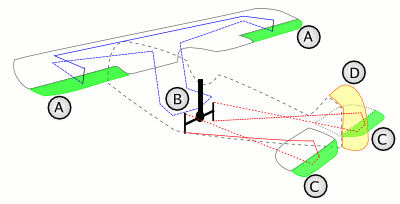 All moveables surfaces of an airplane are designated as control surfaces. In a car, the steered wheels transfer the desire to change direction from the steering wheel to the road. On airplanes this is done by small rotating components on the wings and tail fin, which can be pivoted via control cables or hydraulics from the control stick in the cockpit.
All moveables surfaces of an airplane are designated as control surfaces. In a car, the steered wheels transfer the desire to change direction from the steering wheel to the road. On airplanes this is done by small rotating components on the wings and tail fin, which can be pivoted via control cables or hydraulics from the control stick in the cockpit.
These small or even large control surfaces change the air flow and thus ensure a rotary movement about the respective axis.
The control surfaces can be divided into two groups:
Primary Control Surfaces
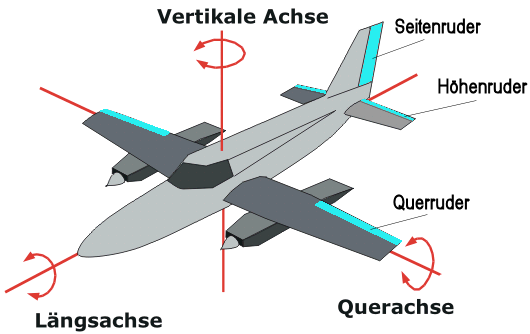 They are used for directional control of the aircraft and do the main work for it.
They are used for directional control of the aircraft and do the main work for it.
The Rudder is vertical on the tail fin and steers the airplane to the left and right.
The Elevator is also located on the tail, but horizontally, making the aircraft lower or lift the tail so it can fly up or down.
The Ailerons are located at the wing edges and are usually asynchronously pivoted, i.e. one up and the other down. The airflow is thus diverted upwards or downwards over the wing, and the aircraft rotates around its longitudinal axis.
Secondary Control Surfaces
These are the control surfaces used to trim the aircraft. These smaller surfaces are usually installed next to the primary rudders or are often a direct component of the primary control surfaces (i.e. a small rudder in the rudder). They are not intended for normal steering when flying, but serve to offset the main surface and thus reduce the required force on the pilot's control stick. The correct trimming allows a reduces pilot workload and makes the aircraft more efficient.
Trim is generally available on all axes. Ailerons, rudder and elevator are ideally all trimmable. Some airplanes have only one or no trim function.
Trim in the following order: rudder, elevator, and aileron.
Flaps and Slats
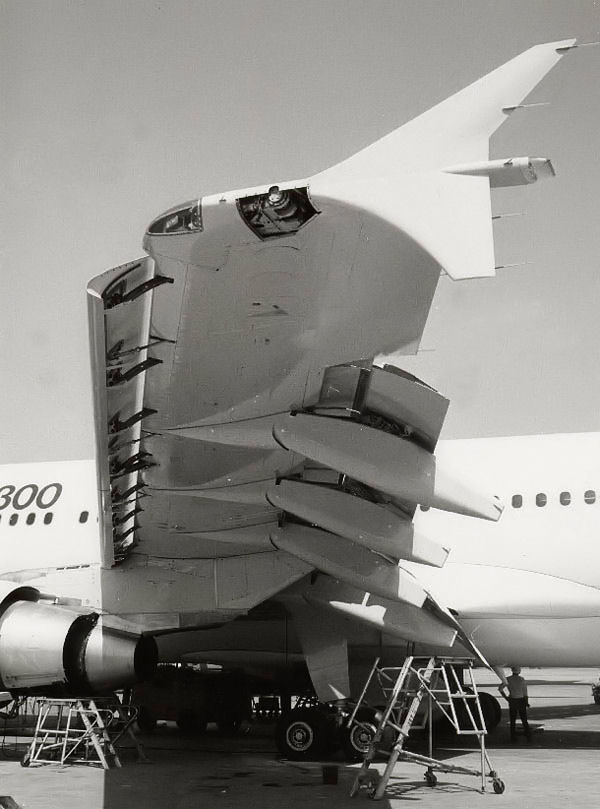 Even the flaps and slats are considered secondary control surfaces.
Even the flaps and slats are considered secondary control surfaces.
Slats. We don't want to go into the subject of slats here, because we'll save that for later. Just this much can be said; a slat is located at the front edge of some airplane wings and increases the lift during slow flying.
Flaps. Much more important is the correct use of the flaps, also called landing flaps, which is actually wrong, because they may also used for take-off.
Flaps are extendable trailing edge wing extensions, which can be adjusted in steps or continuously. This ensures that the air flowing over the wing has to cover an even longer distance to the trailing edge of the wing. We know from aerodynamics that this provides lift. This is why flaps are used both during take-off and landing to give the slow-flying aircraft more lift. This helps to ensure safe flight. Flaps generate an enormous resistance with increasing speed and are therefore only used in certain speed ranges.
5. Undercarriage
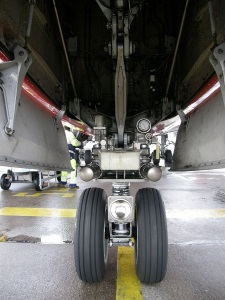 Some aircraft without landing gear actually exist, they have slide rails at the fuselage, but the vast majority of airplanes have landing gear with wheels.
Some aircraft without landing gear actually exist, they have slide rails at the fuselage, but the vast majority of airplanes have landing gear with wheels.
The landing gear allows gentle acceleration, because nothing slides, grinds or glides over the ground. In addition, brakes are installed in the chassis which function like in a car and thus help shorten the landing distance. The landing gear also supports the aircraft on the ground the necessary distance so the propeller does not touch the ground.
Landing gear can be rigid or retractable. A rigid chassis is less complicated, more robust and less expensive to manufacture and maintain. However, it also means a significantly higher air resistance, which has a negative effect on speed, fuel consumption and thus on the range. While rigid landing gear was used in the First World War, retractable landing gear were introduced in the Second World War.
The vast majority of landing gears are so-called three-point undercarriages, where one wheel each is mounted to the right and left in the middle of the aircraft and one wheel either at the very back or at the very front in the centre. Just as a three-legged stool cannot tilt, a three-legged gear ensures that the aircraft is stable and evenly loaded during landing.
6. Cockpit
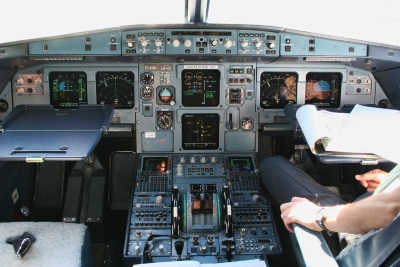 The usual cockpit of an airplane contains all switches and levers to operate the technology and control the airplane. The cockpit also contains the control indicators for all kinds of technical things that should be checked regularly during the flight, such as tank capacity, altitude, speed or the oil pressure of the engine.
The usual cockpit of an airplane contains all switches and levers to operate the technology and control the airplane. The cockpit also contains the control indicators for all kinds of technical things that should be checked regularly during the flight, such as tank capacity, altitude, speed or the oil pressure of the engine.
There are airplanes in which the cockpit is so extensive that there are three and more people employed to control everything, monitor it and ensure a safe flight. However, most cockpits can be operated by one person. Airliners and most private aircraft with two adjacent seats are designed for safety reasons to be controlled from both the right and left side.
If the cockpit is too large, it is divided into different areas for better orientation. Most modern cockpits are divided into thematic modules. This also facilitates the maintenance and replacement of the systems.
Below, as a direct comparison, is an example for an airplane from the First World War (Albatros DV) and that of the A10-A. Top right the cockpit of an Airbus A320.
